Affiliate links on Android Authority may earn us a commission. Learn more.
What to do if your Gmail is not receiving emails
Published onSeptember 28, 2024
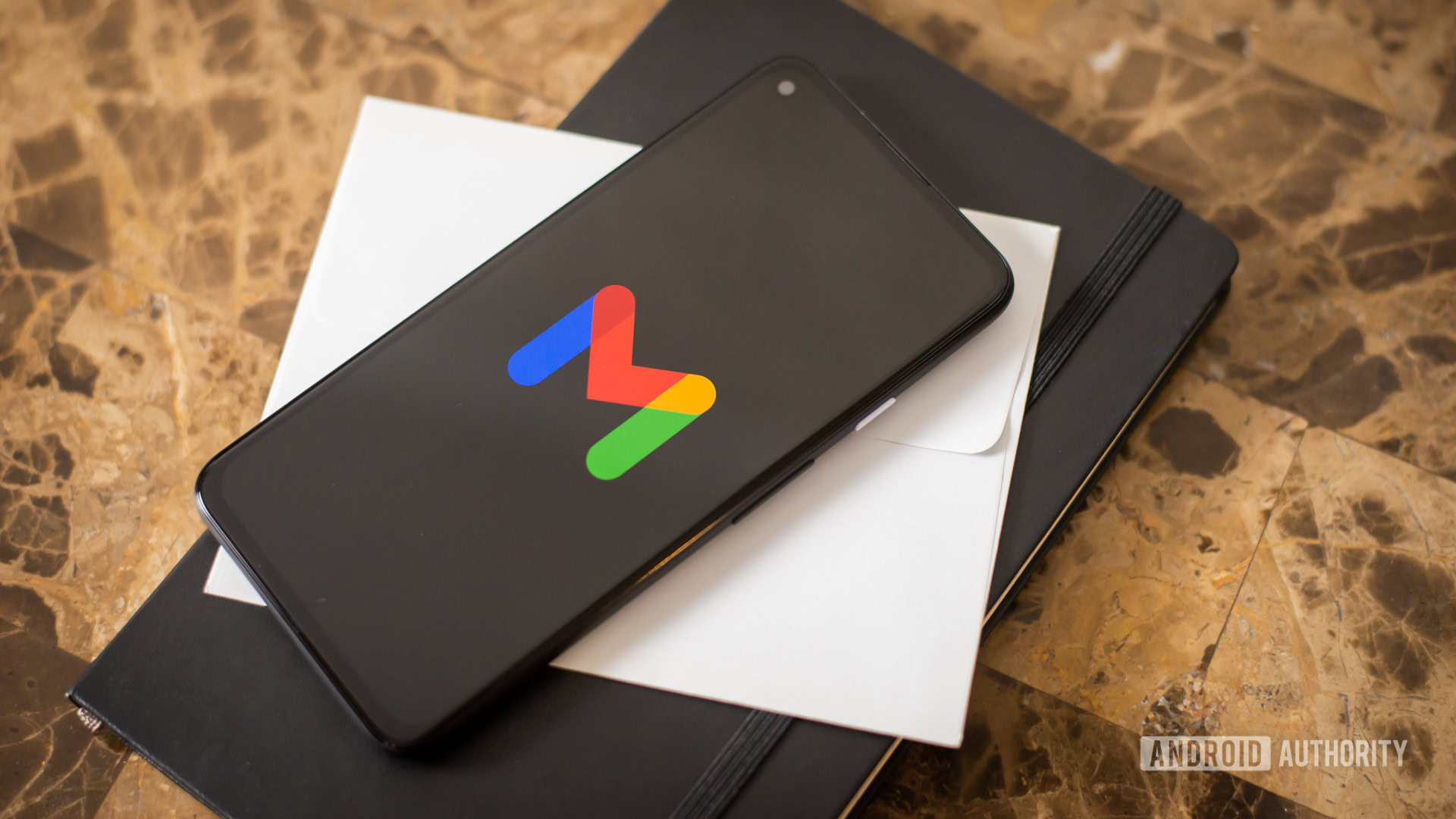
Gmail is the most stable, reliable, and popular email service in existence, but there are still technical snafus that stop your emails from reaching the inbox now and again. This can amount to a minor disaster if the email is important (such as a lucrative job offer). So, what do you do when your Gmail is not receiving emails? Here’s a list of troubleshooting tips you can try if emails are not received in Gmail.
QUICK ANSWER
If your Gmail is not receiving emails, it could come down to a variety of things. The first thing is to check that the email hasn't gone to another folder by mistake (such as the spam folder). You can also check your storage level to see if you've run out of space. And don't forget that your inbox settings could also be misconfigured. Keep reading for more possible fixes.
JUMP TO KEY SECTIONS
- Check your spam folder
- Check your trash
- See if a filter is archiving unread emails
- Do you have storage in your Google One account?
- Check your Gmail IMAP and POP settings
- Are your emails being forwarded elsewhere?
- Check if your Gmail mobile app is configured correctly
- Your internet might not be working
- Is Gmail down?
Check your spam folder first
Let’s start with the easiest possible solution. Even though Gmail’s spam filters are very advanced, they can still accidentally send some emails to the spam folder, even if they aren’t spam. This can be due to a word in the email triggering the spam filter, or many other Gmail users marking that email sender as spam.
- Launch your browser and go to mail.google.com.
- On the left-hand column, expand the option by clicking on More.
- Go into Spam.
- Check for any emails you don’t consider spam. When you find one, open it.
- If you’re sure this is a legitimate email, and not spam, select Report not spam.
- Alternatively, you can click on Move to, and then select Inbox.
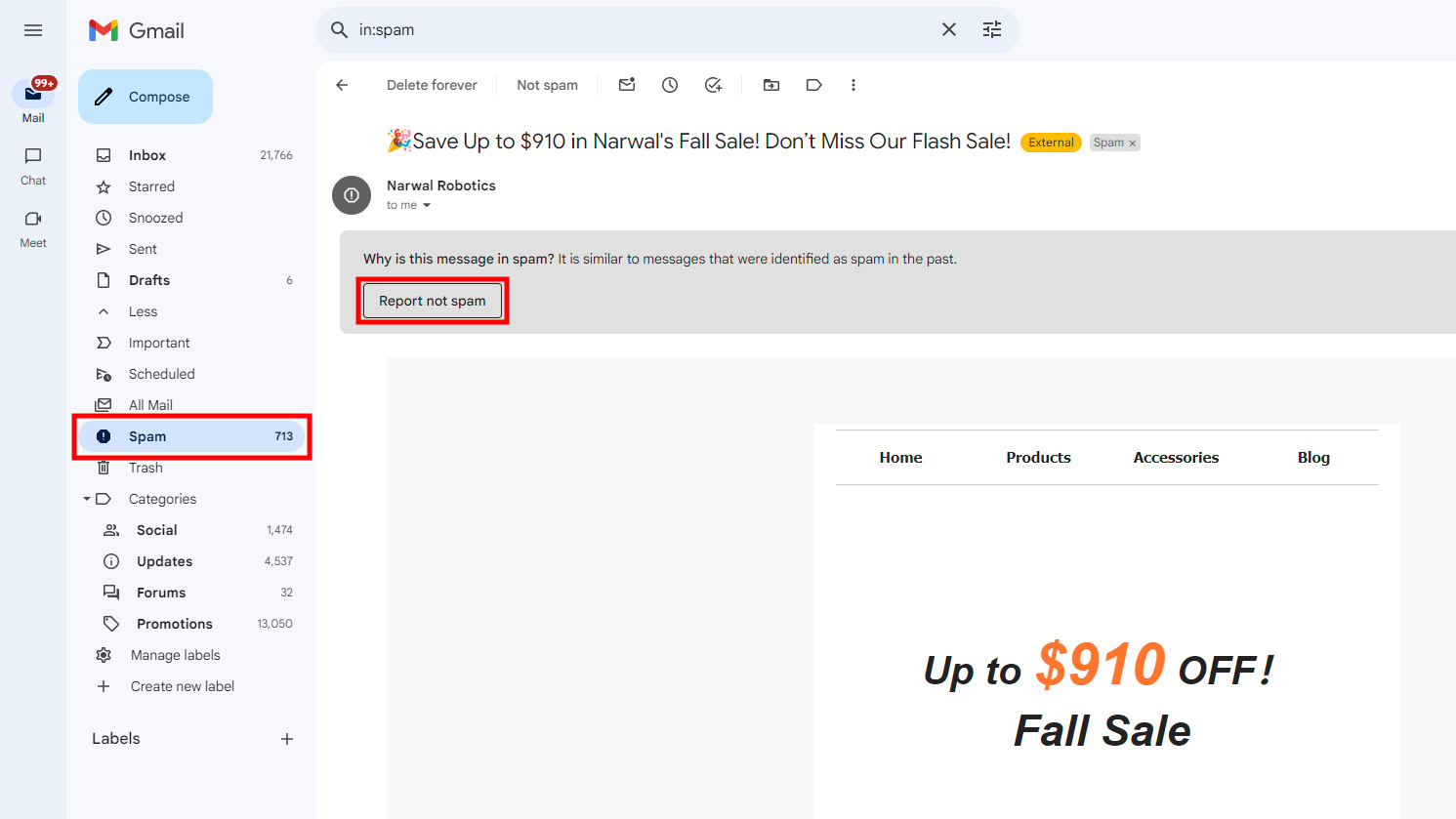
Check your trash
The next step is to see if the email is in your trash. When deleting emails, it’s very easy to get carried away and unintentionally delete emails you didn’t intend to. Check the trash folder.
- Launch your browser and go to mail.google.com.
- On the left-hand column, expand the option by clicking on More.
- Go into Trash.
- Look through any deleted emails. If you find any you don’t consider trash, checkmark them.
- To bring them back to your inbox, click on Move to, then select Inbox.
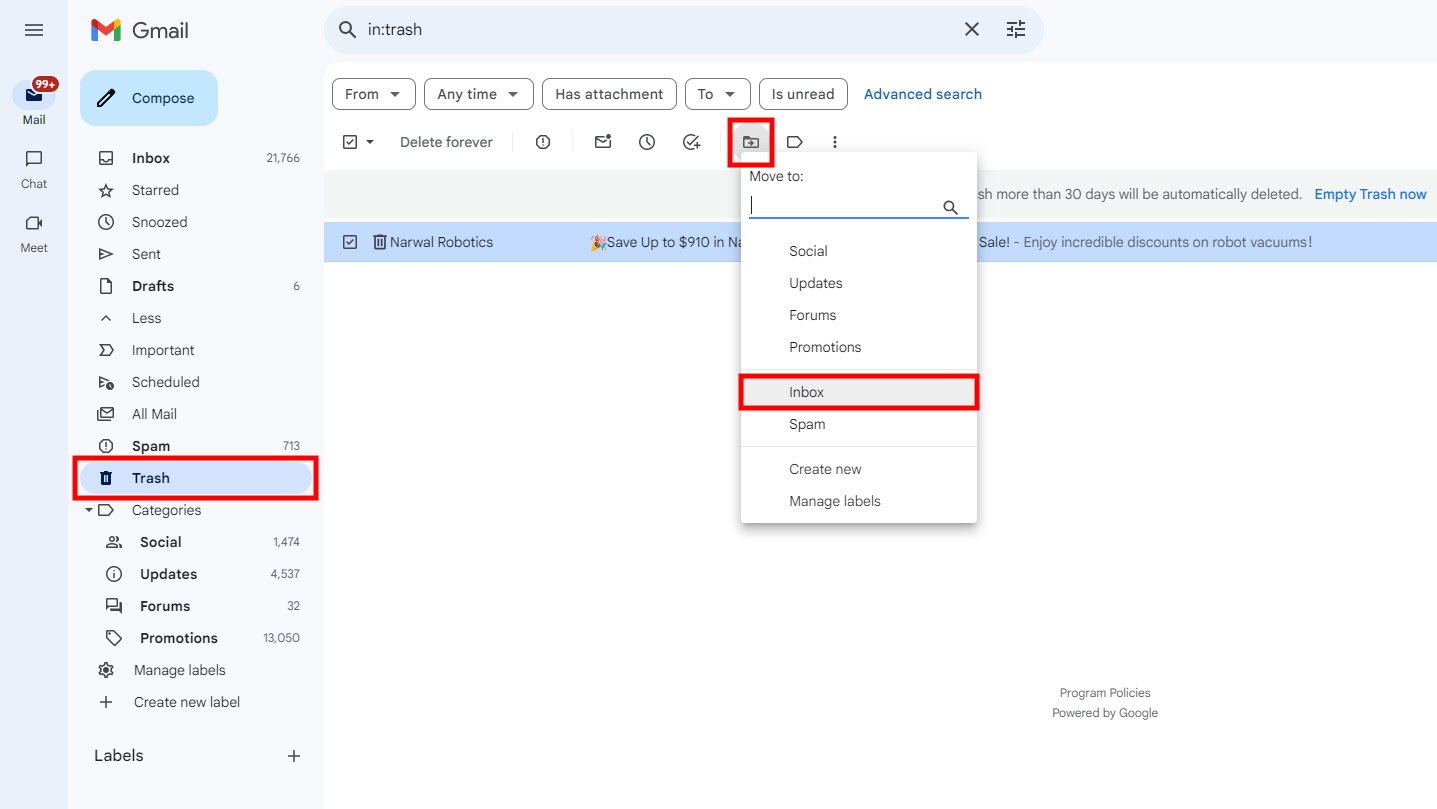
See if a filter is archiving unread emails
Still haven’t found your missing email yet? The next step is to see if a filter has been set up to stop certain emails from reaching the inbox.
For example, you may have set up a filter automatically attaching a label to emails from a specific sender. But you may have also accidentally told the filter to archive the email. So your “missing” email is actually there, but it’s in the label folder.
- Click on the relevant label on the left-hand side of the inbox and see if your email is sitting there.
- If it is, go to your filters list and amend the filter to stop it from happening again.
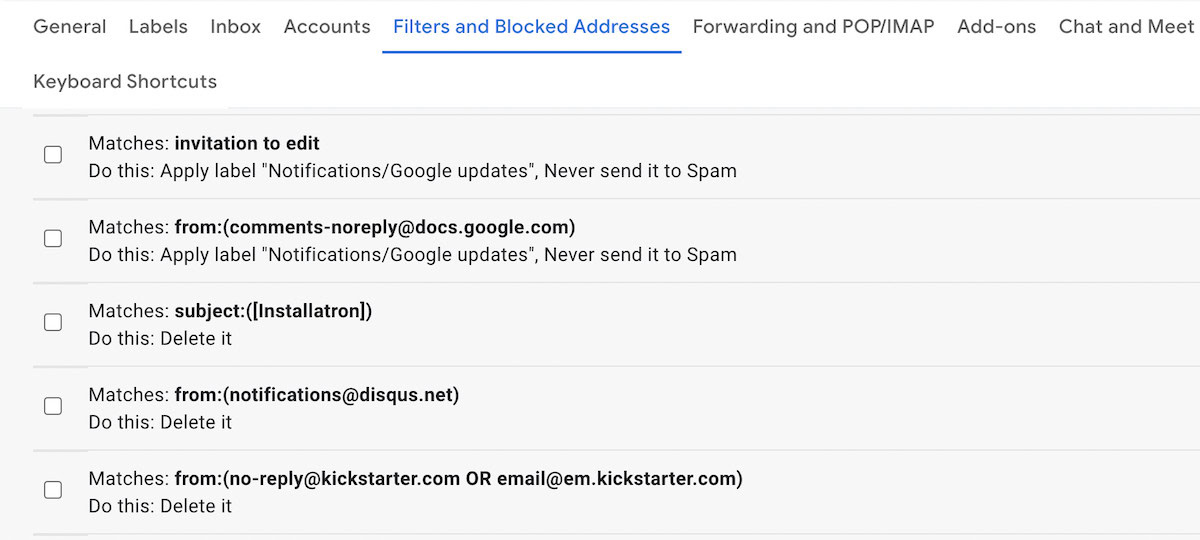
Do you have storage in your Google One account?
Google gives everyone a very generous 15GB of free storage space, but it’s amazing how fast that storage can get eaten up. All it takes are some huge email attachments, and suddenly, you’re getting prompts to upgrade your Google One account storage. Don’t forget that other Google services — such as Drive and Photos — also count toward your total storage.
You can go to your general storage overview page to see how your current storage is used. If you’re getting close to the limit, or you’ve reached your limit, then Gmail could be blocking emails from reaching you until you upgrade. If you don’t want to upgrade to a paid plan, consider deleting some things from Gmail, Drive, or Photos. Otherwise, you’ll just have to pay for more Google One storage.
Check your Gmail IMAP and POP settings
If you use Gmail’s IMAP or POP settings, then it’s a good idea to check that those are working as they should. Otherwise, you might miss some emails, or emails you’re trying to send might not go through.
- Launch your browser and go to mail.google.com.
- Click on the Settings gear icon.
- Select See all settings.
- Click on the Forwarding and POP/IMAP tab.
- Enable these settings, if they are disabled.
- Click on Save Changes.
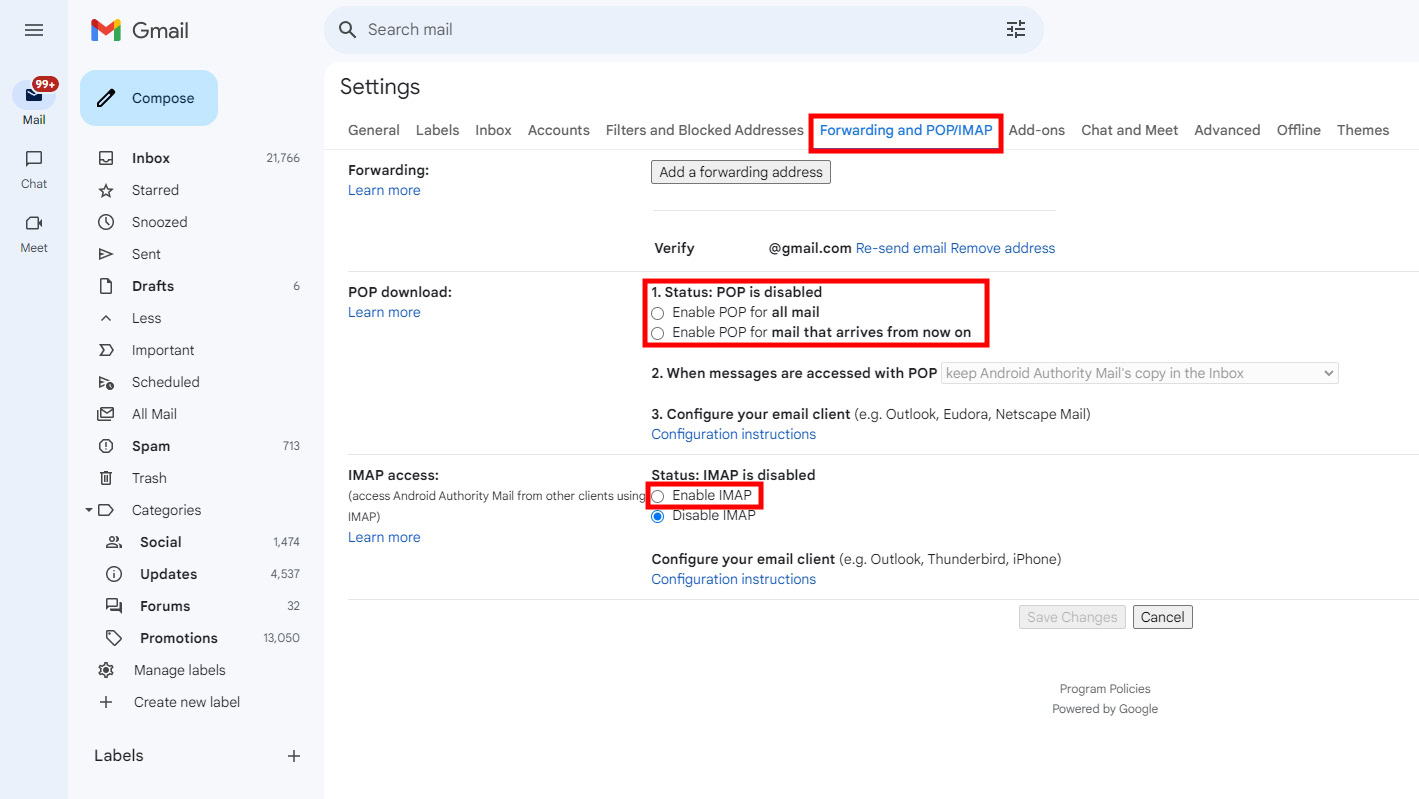
Are your emails being forwarded elsewhere?
In the Gmail settings, you can automatically forward some or all emails to another email address. But again, filters can be very fickle things, or maybe you’ve forgotten you’re forwarding certain emails to another email address.
- Launch your browser and go to mail.google.com.
- Click on the Settings gear icon.
- Select See all settings.
- Click on the Forwarding and POP/IMAP tab.
- Look under the Forwarding section, to check if you’re sending your emails elsewhere.
- If you are, click on Remove address next to the email address.
- Hit OK to confirm.
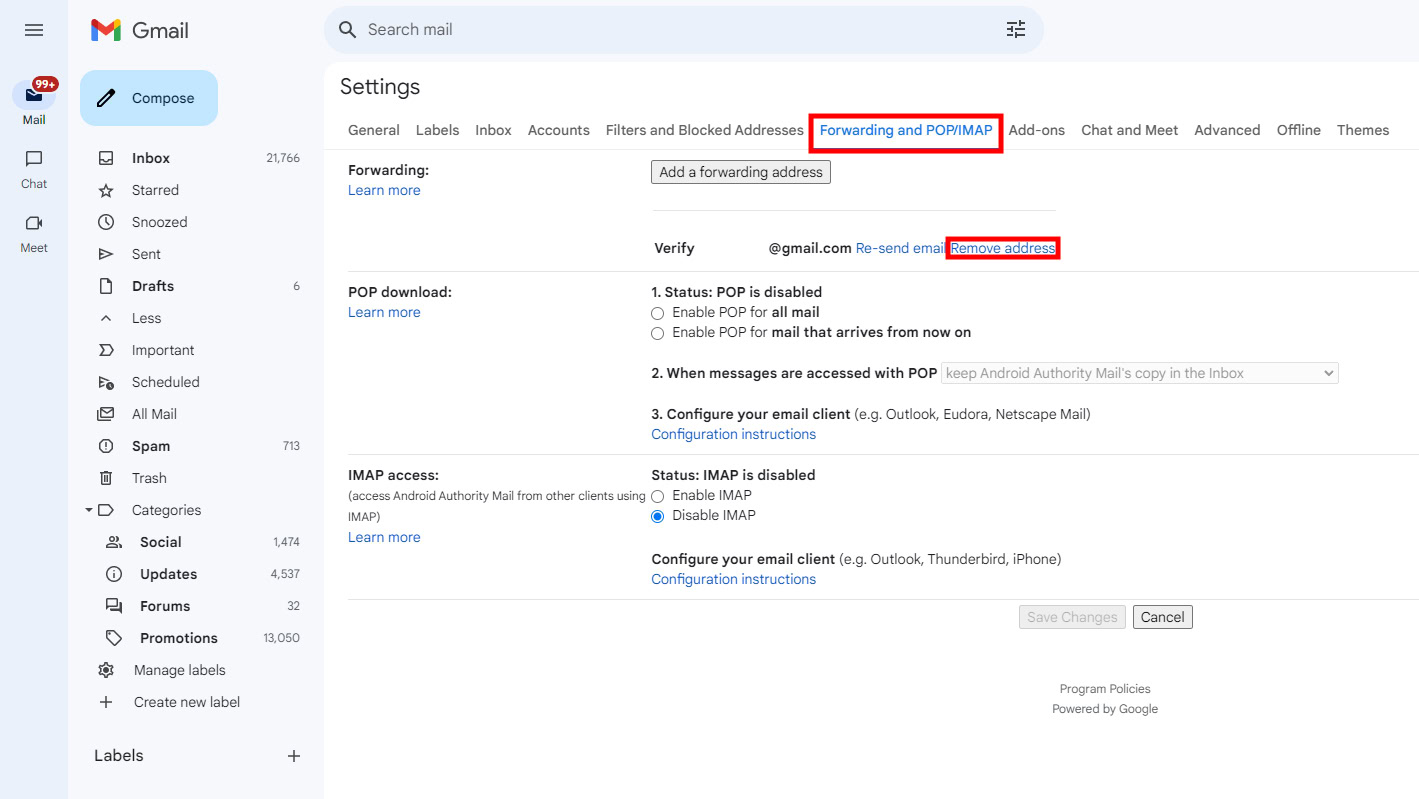
Check if your Gmail mobile app is configured correctly
If you’re using Gmail’s mobile app, it’s entirely possible you haven’t set up the app correctly. Or maybe you reset the password on the desktop and forgot to change it on the mobile version? Regardless, the easiest way to fix this is to simply remove your Google account and re-add it.
- Launch the Gmail app.
- Tap on your profile icon.
- Select Manage accounts on this device.
- Tap on the email you’re not receiving emails on.
- Pick Remove account.
- Confirm by hitting Remove account again.
- Re-add the Google account.
Your internet might not be working
This one may sound silly, but we often overlook the obvious. If your Gmail is not receiving emails, maybe your Wi-Fi connection has suddenly blinked out, and you haven’t noticed. Or perhaps your internet connection is a bit sluggish, making it difficult for Gmail to send large emails?
Whatever the reason, turn your Wi-Fi connection off and then on again. If that doesn’t work, restart your computer or phone. If the Wi-Fi connection is still really bad or totally gone, it’s time to reset your router. But before that, maybe do a speed test first? Most routers have a reset button or can be restarted using an official app. If you can’t figure those out, simply unplugging the router, waiting about a minute, and plugging it back in will do the trick.
If you’re on your phone, check your data plan. Do you still have data, or have you run out? Have you even got your mobile internet switched on? Let’s show you how to turn on cellular data. I know I’ve turned it off by accident in the past!
- Launch the Settings app.
- Go into Network & internet.
- Tap on SIMs.
- Toggle on Mobile data.
- To enable roaming, tap on your main SIM and then toggle Roaming on. Just keep in mind that this may incur extra fees, depending on your carrier and plan. Check first!
Is Gmail down?
While rare, Google’s servers can fail, too, and it happens occasionally. If you’re expecting an email and have issues with Gmail not receiving emails, there is a chance it’s just Google’s servers being down. Google Workspace has its own status page, where you can check if there are any issues affecting Google’s services, including Gmail.
Additionally, you can use a third-party page like DownDetector.com. This page is crowd-sourced, so you will be able to get results base on user reports, and there’s also a cool live map that can show you if it’s a local issue.
If Gmail is down, all you can do is wait for it to come back up.
FAQs
Your notifications may not be working because you haven’t enabled them. In the desktop Gmail General settings, scroll down to Desktop notifications and switch them on. If it still doesn’t work, maybe you’ve told your browser to block all notifications for Gmail. In that case, you need to enable them again in the browser settings. Go into the Gmail settings or device settings in the mobile app, and enable notifications.